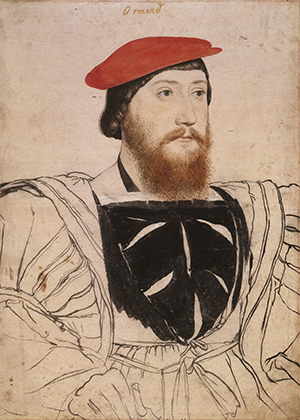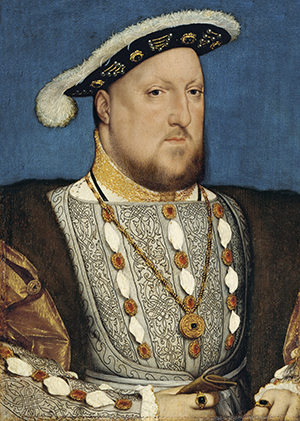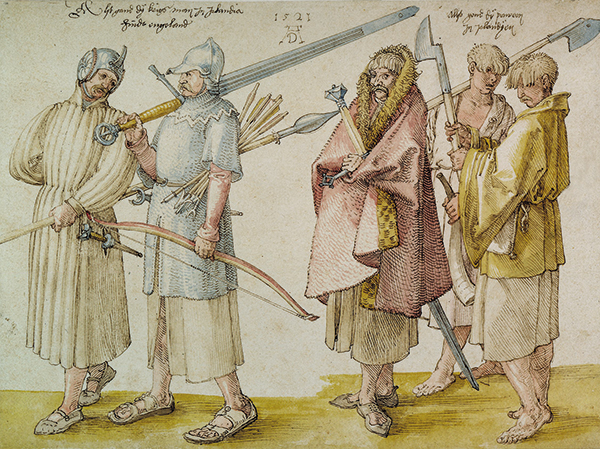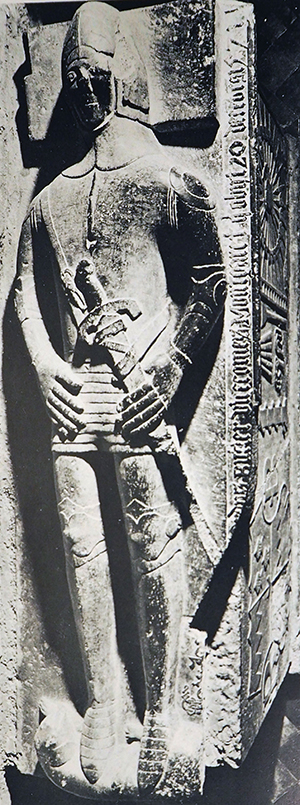A ‘new departure’ in mid-Tudor Ireland?
Published in Early Modern History (1500–1700), Features, Issue 3 (May/June 2018), Volume 26The Ormond–St Leger feud.
By Alan Bryson
By spring 1544 the lord deputy of Ireland, Sir Anthony St Leger, faced growing criticism of his policies, especially among supporters of the most powerful Irish nobleman, James Butler, ninth earl of Ormond. He still had the backing of King Henry VIII, however, and, in comparison with the previous lord deputy, Lord Leonard Grey, proved too difficult to topple when Ormond and he finally fell out in autumn 1545 over the direction of government. St Leger must have been mindful of Grey’s fate: isolated from the king’s good graces, then brought down in 1540–1 by a cabal led by Ormond and the lord chancellor, John Alen, with St Leger’s own connivance. During 1545 and 1546 Ormond and he struggled for power, the fallout from their conflict shaping politics until the end of St Leger’s career in 1556. Why and how had this happened?
The Ormond–St Leger feud typified relations between England and Ireland in the aftermath of Kildare’s rebellion (1534–5), when direct rule by a lord deputy superseded government on behalf of the Tudor monarchy by an Anglo-Irish nobleman. Now a succession of lord deputies competed with the Anglo-Irish over defence of the Pale, how to deal with the Gaelic Irish chieftains and office. Much recent research on the sixteenth century also links court faction to office in Ireland. For example, St Leger is seen as the client of the Howard family. It is clear that both men (and their peers) reacted to local events and appealed to the king and English government for support. That is, faction shaped politics but originated in Ireland, not at court. By privileging the primary sources over what other historians have said, we get a better understanding of the feud and of mid-Tudor politics in general.
The feud’s significance lies in its impact on Irish government. If there was a period of political consensus in the aftermath of Kildare’s rebellion, historians like Brendan Bradshaw have found it during St Leger’s early years as lord deputy, and its breakdown led to garrisoning, colonisation and, eventually, conquest. Was this (as Bradshaw argues) a lost opportunity and the revival of a familiar pattern of vice-regent/noble conflict, or was it the norm of politics (as Steven Ellis says)?
‘He would have no man to rule in the parts where he is but himself’
The Englishman Sir Anthony St Leger was first named lord deputy in July 1540. He understood that Ireland ‘is much easier won than kept’ and focused on re-establishing royal authority within the Pale and on forging good relations with nobles like Ormond. His biggest achievements were persuading many of the chieftains to accept English forms of land tenure and of inheritance over the existing system of partible inheritance (a policy that has come to be known as ‘surrender and regrant’ and that fundamentally reshaped society and the economy), persuading Henry VIII to accept the kingship of Ireland by parliamentary statute in June 1541 and maintaining the peace.

Above: James Butler, ninth earl of Ormond (d. 1546), drawn by Hans Holbein the Younger c. 1537. Ormond was the most powerful magnate in mid-Tudor Ireland. He clashed with the English-born lord deputy, Sir Anthony St Leger, over how best to govern the country. (Royal Collection, London)
Relations between Ormond and St Leger became strained from as early as 1541 but did not break down until autumn 1545, over the earl’s suspicion that his commission to lead a military expedition as part of the king’s war against Scotland was really a ploy to remove him from Ireland, perhaps permanently. The origin of their feud appears to be more prosaic, however: in autumn 1544 the lord deputy spoke out against Ormond’s obtaining Kilkea Castle in County Kildare from the crown in exchange for lands and castles in the south of County Kilkenny, which lay within the heart of the earl’s lordship, where much of his authority was concentrated. The government wanted these castles in order to hem in the powerful Kavanagh sept, to conquer the disputed border territory of southern Leinster in County Wicklow, and to guarantee communications with the south-west down the only viable land route, the Barrow valley. Ormond now dragged his feet over the exchange, but it was not until late February 1545 that St Leger informed the English lord chancellor, Thomas Wriothesley, of this intransigence and of the growing animosity between the two men. Whenever an issue arose that Ormond believed touched on his own affairs, all the Anglo-Irish members of the privy council backed him—even over the king, the lord deputy claimed. Having sounded things out first with Wriothesley, St Leger wrote to the English government in mid-April criticising Ormond further. Though the earl was Henry’s ‘true and faithful subject yet I am well assured that he would have no man to rule in the parts where he is but himself and accumulate all the whole rule’. This was the problem in a nutshell, as it had been between one of St Leger’s predecessors, Sir William Skeffington, and Gerald Fitzgerald, ninth earl of Kildare, in the early 1530s, and between Grey and Ormond at the close of the decade. Ormond felt threatened by St Leger for any perceived encroachment on his own power.
The situation deteriorated sharply in autumn 1545. Ormond claimed that as he passed through a crowd while leaving his castle at Gowran, Co. Kilkenny, on his way to embark for Scotland an unknown individual pressed a letter into his hand. It declared that St Leger was plotting against him and that he was to be sent to the Tower of London. Everybody knew that the lord deputy was ‘the most dissembling and most crafty man that ever came among them’, who bribed and embezzled, lied about the state of the realm to the king, and blamed others for the violence and disorder there. In fact, with his brother, Robert St Leger, he was the root cause of many of the country’s problems through corruption and through alliances with the Gaelic Irish.
The feud begins
The Scottish expedition failed to achieve its main objective and was of only limited success. On his return to Ireland, Ormond upped the stakes by writing to Wriothesley in December 1545 to voice his complaints against St Leger. He said that he had tried to work with the lord deputy but found his hatred towards him too much to bear, accusing him of creating a faction against him. Thus the feud began between them, with charge and counter-charge levelled in letter after letter.

Above: Henry VIII, king of England (1509–47) and of Ireland (1541–7), by Hans Holbein the younger c. 1537. Henry was unable to fund the government of Ireland properly and relied on the support of loyal magnates like Ormond. He resolved the Ormond–St Leger feud in September 1546, attempting to be as conciliatory and even-handed as possible. (Google Art Project)
The Irish privy council intervened early in January 1546 to resolve the differences, but without success. They feared brawls and open fighting should Butler and St Leger supporters meet, even in the streets of Dublin, and the following month petitioned for the matter to be decided in England, with some nobleman sent over to act as governor in the meantime. While several privy councillors criticised the lord deputy, they were still remarkably conciliatory and even-handed in their assessment of the situation, although faction had implicitly become a major problem. They concurred with Ormond over what should be investigated: the general state of the realm; whether revenue and Pale security had increased significantly since St Leger’s appointment in 1540; how far the king’s writ ran; the behaviour of recently ennobled chieftains; and whether southern Leinster had been pacified or not. The successful absorption of southern Leinster into the Pale, which would stabilise the frontier with the Gaelic Irish septs and open the way for expansion of crown authority to the south-west, depended on Ormond and St Leger setting aside their differences.
In mid-February 1546 the English government agreed with the Irish government to resolve the dispute at court. As St Leger put it, the aim was to make his accusers, ‘who long have had veiled faces’, appear before them. Prior to departing for England he gathered the nobility and privy council at Dublin on St Patrick’s Day in a clever show of strength, to sign a letter of support to Henry. Some of the most important chieftains were also there. These chieftains wrote to the king, praising the lord deputy and implying that only a man with similar qualities was up to the job. Sir Thomas Cusack, keeper of the great seal, famously reinforced the point: ‘those which would not be brought under subjection with 10,000 men come to Dublin with a letter’.
Prompted by a questionnaire from the English government to the Irish government, the lord chancellor, John Alen, spoke out publicly against St Leger in May. His motivation was more complicated than malice, however: he argued that St Leger was a failure in office and implied that he had sidelined his fellow privy councillors. Alen claimed that the king’s authority was accepted only within the Pale; the lord deputy’s policy of surrender and regrant had been unsuccessful because the Gaelic Irish were disobedient, while the military and political power of their chieftains had been strengthened by the government’s recent conciliatory attitude towards them. In a second document he drove his points home more succinctly, accusing St Leger of corruption and partiality. Henry was king in name only.
St Leger produced a detailed rebuttal, enumerating the weakened military strength of the Gaelic Irish on the Pale’s borders, defending surrender and regrant, and denying malfeasance (a charge that would come back to haunt him in 1556) or cronyism. If Alen, Ormond or the principal solicitor, Walter Cowley, had their way, he asserted, Henry would be king neither in name nor in fact.
The ‘lewd book’
Although not apparent immediately, Alen had plotted against St Leger since late 1545. He employed a stalking-horse at first. At his prompting, early in the New Year Cowley devised a series of articles attacking the lord deputy and defending Ormond. Alen and others further amended this ‘lewd book’, as it was subsequently called, claiming that St Leger was involved in politically motivated murders and other outrages within the Pale, including rape. The ‘lewd book’ was intended to circumvent the lord deputy’s good court connections by putting across his opponents’ points directly to the king and the English privy council. It backfired, however, landing Cowley in the Tower of London in April 1546.

Above: ‘Thus go the soldiers of Ireland beyond England’—Albrecht Dürer’s 1521 watercolour. Ormond led 1,000 such men on an expedition to Scotland in November 1545. It failed in its main objective—the seizure of Dumbarton Castle on the Firth of Clyde for the king and the restoration of Dómhnall Dubh MacDonald as lord of the Isles—but succeeded in its more limited one of ‘annoyance of the Scots’. (Kuperferstichkabinett Staatliche Museen, zu Berlin)
The depositions and petitions that Cowley made from the Tower between April and June 1546 provide the fullest account of the political breakdown in Ireland over the previous year. In desperation, Cowley now blamed Ormond’s client, William Cantwell, for everything (and implicitly blamed Alen too). He claimed that Cantwell had told Ormond late in 1545 how St Leger was pressuring him into speaking out to the king against him. This, and rumours within his own household, caused Ormond to write to the English lord chancellor, Wriothesley, in December, and it was this action (as we saw) that started the feud. Cowley’s most remarkable claim was that Ormond and he devised the Gowran letter themselves in order to protect Cantwell from being singled out as St Leger’s first accuser. They understood that, as a pretext to his fall, his enemies would concoct charges against him, which the earl would be summoned to England to answer. If, however, he alleged that his life was in danger, Ormond could write for licence to come to court himself and forestall those enemies. Therefore both St Leger and he wanted matters settled at court, St Leger petitioning directly for such an outcome, the earl using more unorthodox methods to achieve the same end.
Resolution

Above: The tomb of Sir Richard Butler (d. 1571) in St Canice’s Cathedral, Kilkenny. Ormond’s untimely death from food poisoning in October 1546 left an underage son as his successor. Government efforts to control his lordship proved unsatisfactory and ‘the rule of the counties of Kilkenny and Tipperary [was] committed to’ his widow Joan Butler, countess of Ormond, and to his brothers Edmund Butler, archbishop of Cashel, and Sir Richard Butler.
In the end the dispute had to be resolved, and there could only really be one choice: to back St Leger. He had brought relative peace and stability to Ireland, with no major rebellions since the 1530s, and Irish soldiers had even served in Henry’s French and Scottish wars in 1544 and 1545. In September 1546 the king passed judgement on the feud, and here we see him at his most proactive and positive, perhaps mindful of what had befallen Grey as a consequence of faction in 1541. While Ormond’s authority was curtailed on several fronts, including loosening his grip on cadet branches of his family, Henry was even-handed and supported him where his interests did not challenge the crown’s. In addition, a quorum of Irish privy councillors was created to attend on St Leger at all times in case any pressing business arose needing immediate action. This reform originated with the privy council itself and could be viewed as an attempt by them to curb the lord deputy’s power.
Any hope that the outcome of the feud would be to reconcile former enemies was dashed, however, by Ormond’s untimely death from food poisoning in London on 28 October 1546, which left an underage son as his successor. St Leger was reappointed in November, but County Kilkenny and the route to the south-west now lacked powerful leadership, and government efforts to control the Ormond lordship proved unsatisfactory. It was clear that only the Butler family, now headed by Ormond’s widow and his brothers, had sufficient authority within the lordship, so that any attempt to ‘civilise’ southern Leinster must be done in partnership with them. Indeed, the ‘sudden power vacuum’ (Ciaran Brady) created by Ormond’s death may have contributed to the Midland Rebellion in 1547, which was started by the O’Byrne sept of southern Leinster.
Conclusion
The Ormond–St Leger feud is very complicated and will continue to be debated. It was caused by St Leger’s efforts to limit Butler power in order to prevent something like another Kildare ascendancy, which Ormond regarded as government hostility towards him. And it was mainly a fight about power rather than policy, although it fits into the broader question of how best to govern Ireland—through delegation to an Anglo-Irish noble or through an English viceroy. It was not caused by court faction, though. St Leger never accused Ormond of disloyalty to the king. While the two men worked together during the early 1540s Ireland was stable and well governed, and the breakdown in their relationship (perhaps inevitable because of these tensions between crown and private authority) created faction and could only be resolved ultimately by the king. The feud’s outcome was unsatisfactory for both men, leading to Ormond’s disgrace and hobbling St Leger politically, contributing significantly to his removal from office in 1548. The principal reason for St Leger’s dismissal, however, was his inability to deal with the Midland Rebellion, which broke out in spring 1547, not Henry’s death in January or court faction. What followed was a ‘new departure’ for Ireland: the Protestant Reformation, confessional politics, colonisation and conquest. The Ormond–St Leger feud has had serious repercussions.
Alan Bryson is a curator at the British Library.
FURTHER READING
- B. Bradshaw, The Irish constitutional revolution of the sixteenth century (Cambridge, 1979).
- C. Brady, The chief governors: the rise and fall of reform government in Tudor Ireland, 1536–1588 (Cambridge, 1994).
- A. Bryson, ‘The Ormond–St Leger feud, 1544–6’, Irish Historical Studies 38 (2012).
- S.G. Ellis, Ireland in the age of the Tudors, 1447–1603: English expansion and the end of Gaelic rule (London, 1998).
















